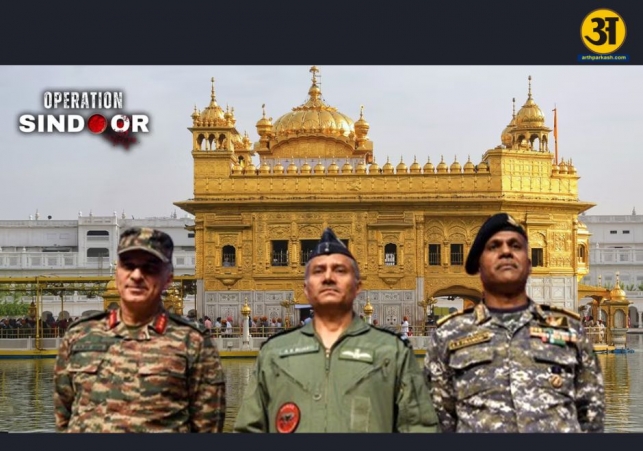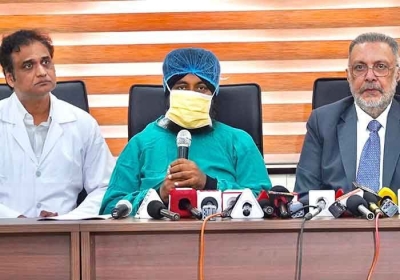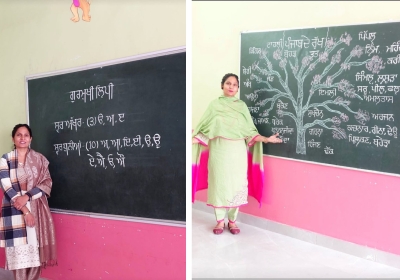
Army placed air defence guns in Golden Temple with granthi’s nod
Golden Temple head granthi allowed Indian Army to place air defence guns during Operation Sindoor, says officer
- By Gurmehar --
- Monday, 19 May, 2025
In a major revelation, Lieutenant General Sumer Ivan D'Cunha, Director General of the Indian Army's Air Defence, said that the Indian Army was given permission to deploy air defence guns inside the Golden Temple premises during Operation Sindoor. This operation was conducted in response to drone and missile threats from Pakistan between May 7 and May 10, 2025. The permission came after army officials explained the seriousness of the threat to the Golden Temple authorities.
The cooperation from the Golden Temple was unprecedented. It included switching off the lights of the shrine for the first time in history to help defence forces clearly see and shoot down any incoming drones. The head granthi (chief priest) of the temple was praised for his understanding and timely support. This action helped Indian forces better defend the area and protect civilians from danger.
How army and temple worked together
The army had expected that Pakistan might target religious places in India to create confusion and fear among the public. They believed that Pakistan would aim at civil and religious spots instead of proper military targets. Because of this, the Indian Army made preparations to protect key locations such as the Golden Temple, one of the most visited and important religious places in the country.
Lt General D'Cunha explained in an interview with news agency ANI that the lights of the Golden Temple were switched off at night. This helped the army to clearly spot the drones flying in from across the border. Usually, bright lights make it harder to see objects in the night sky. By switching off the lights, the army could better track and shoot down any threats.
He said, "It was very nice that the head granthi allowed us to deploy our guns. It is possibly for the first time in many years that they switched off the Golden Temple lights so that we could see the drones coming." He added that such cooperation was only possible because the army explained the serious risk to the temple.
After India’s successful strikes on terror hubs in Pakistan-occupied Kashmir (PoK) and Pakistan’s Punjab province, Pakistan launched missile and drone attacks in response. These attacks affected a wide range of areas — from Jammu and Kashmir to Gujarat. Amritsar, where the Golden Temple is located, was also targeted during the attacks.
According to Lt General D'Cunha, Pakistan had no clear military targets. Instead, they tried to create chaos by attacking public and religious places. He said, “They were more interested in creating confusion and chaos internally.”
The army believed that protecting a site like the Golden Temple was critical not only because of its religious value but also because of the large number of visitors it receives daily. If a drone hit the temple or the nearby area, the damage and loss of life could be severe.
To avoid such a disaster, the army took proactive steps. They held meetings with the temple management, explained the risk, and got permission to place guns near or inside the premises. This allowed the army to be prepared and act quickly if any threat approached the holy site.
ALSO READ: Rajnath Singh visits second military base, asks IMF to rethink aid to Pakistan
Drones shot down, attacks prevented
During the four-day attack period, the Golden Temple lights remained off at night as a precaution. This helped the army focus their surveillance and respond to any aerial threat more efficiently. The blackout wasn’t just limited to the temple. The surrounding area of Amritsar also experienced power cuts to help detect flying objects better.
Fortunately, the Indian Air Defence was successful in stopping almost all the drones and missiles. None of the attacks caused significant damage to the temple or the city. The threat eventually ended on May 10, after a ceasefire understanding was reached between India and Pakistan.
These events showed the Indian Army’s preparedness and also how religious institutions like the Golden Temple can cooperate in national defence when needed. Lt General D'Cunha praised the support and understanding shown by the head granthi and the temple’s management. Their decision helped protect one of India’s most sacred and symbolic places from possible damage.
The operation was historic not only because of the army's success but also because of the temple’s role in it. It was the first time the Golden Temple management had allowed air defence guns to be deployed within its premises. It was also the first time in modern history that the temple’s lights were switched off for defence purposes.
The Director General of Army Air Defence stressed that such coordination between defence forces and religious bodies sends a powerful message. It shows that during national emergencies, all sectors of society can come together for the safety of people and places of worship.
Lt General D’Cunha’s statements shed light on the behind-the-scenes efforts made by the army and religious authorities to keep citizens safe. Operation Sindoor will now be remembered not only for its military importance but also for the joint action taken by soldiers and spiritual leaders in defence of the nation.





